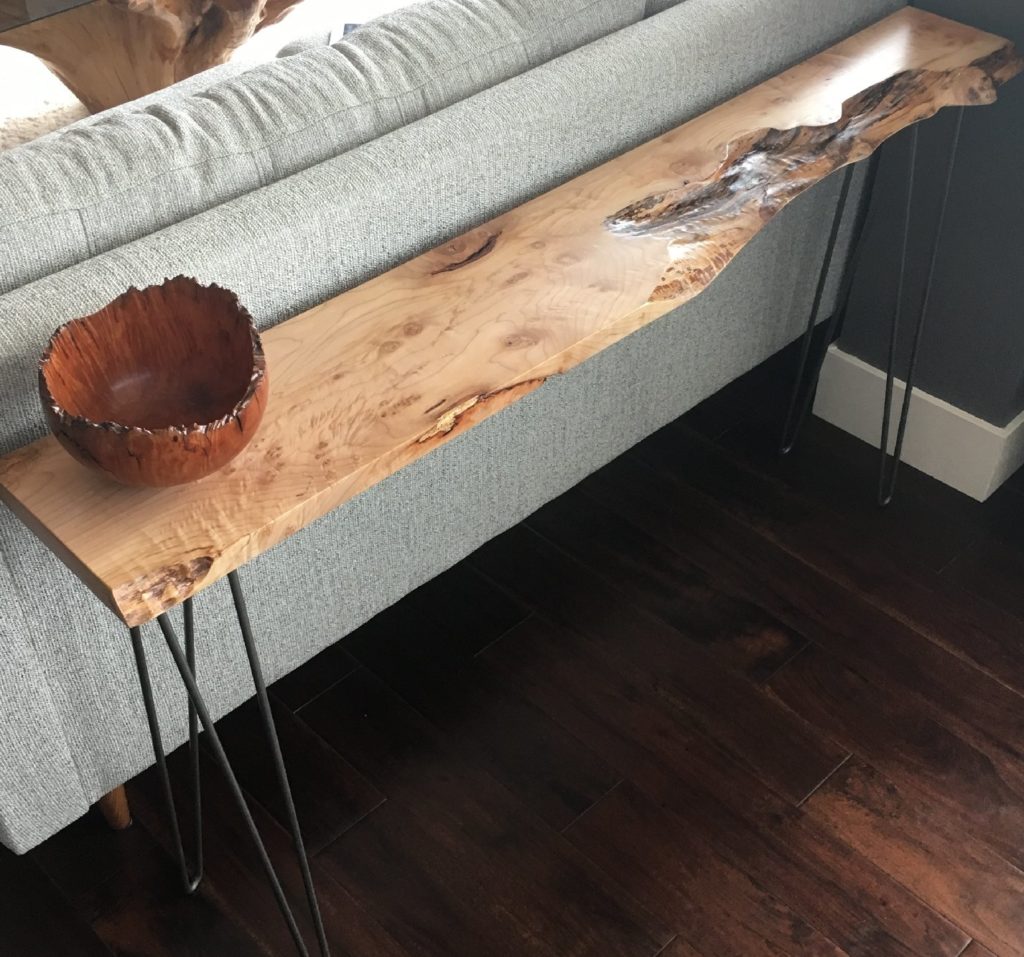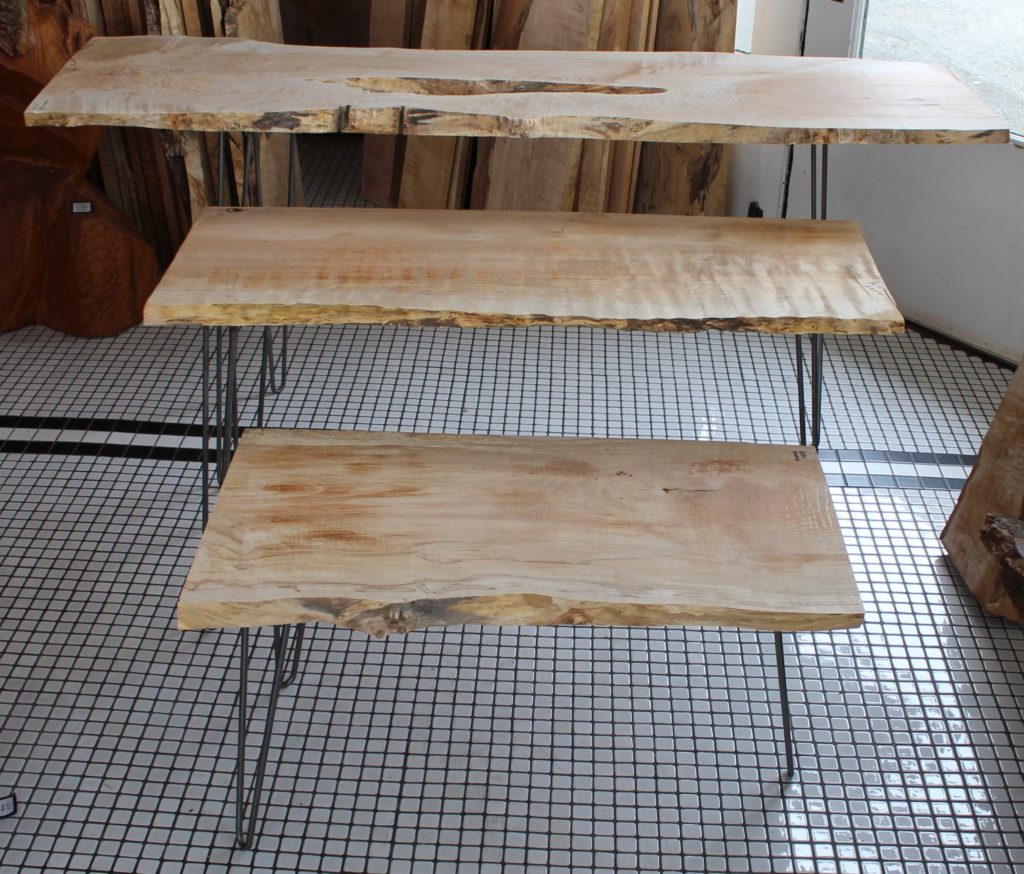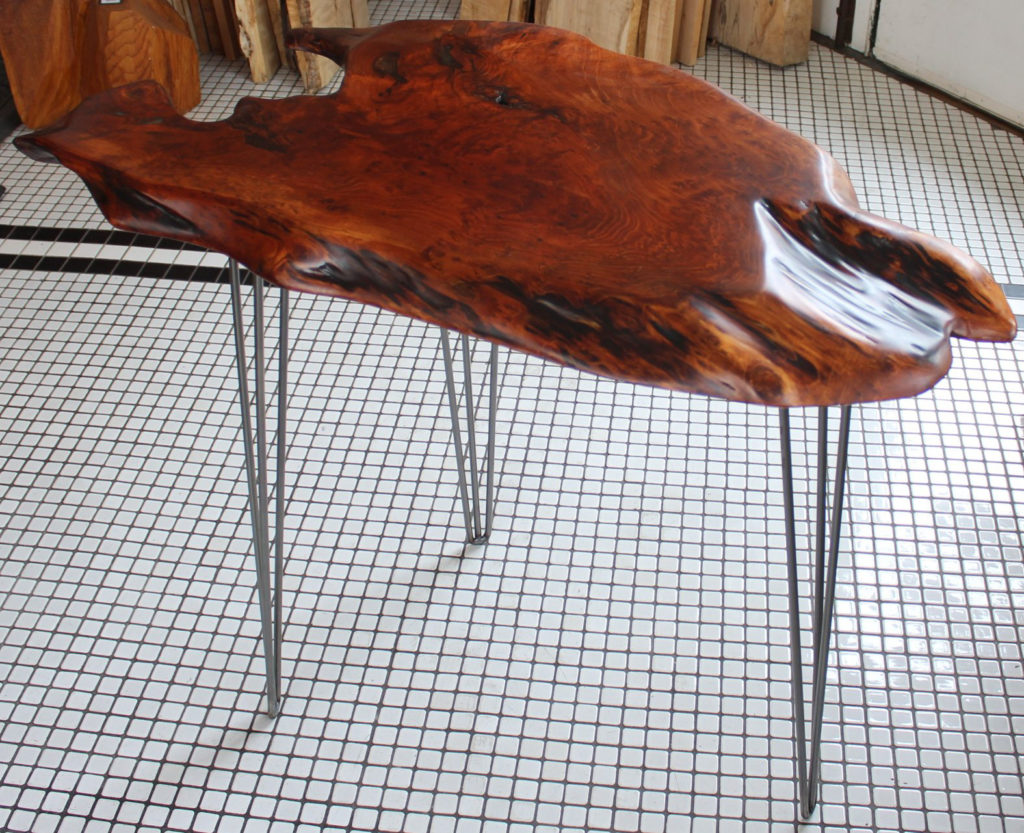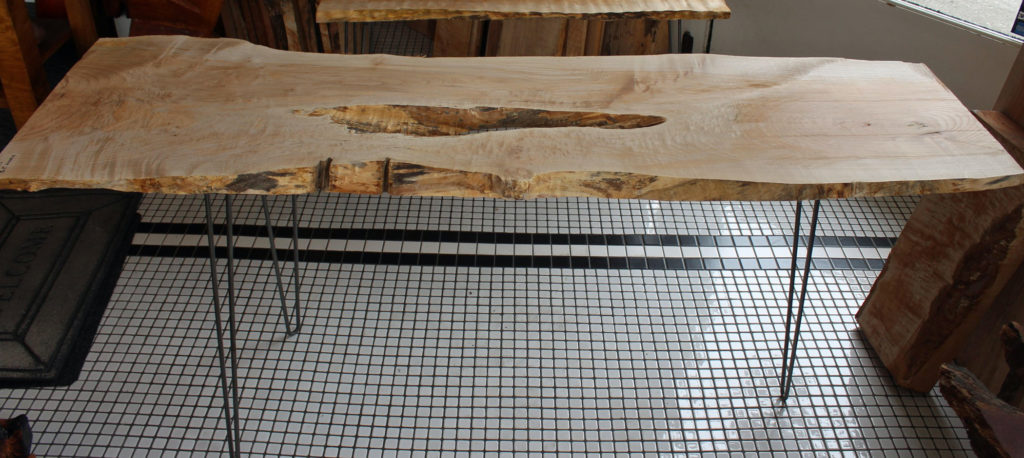Hairpin Legs
Hairpin legs are often used on our Finished Redwood Tables, and other Custom Woodworking pieces. The Redwood Shed and River Table page have tops that can work well with hairpin legs.
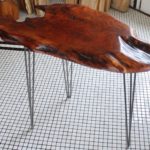
There are many other things you can do with a piece of natural edged wood, aside from attaching legs to it to make a table. Cutting boards, sculpture bases, window sills, live edge shelves, mantels, freeform wall pieces, and charcuterie boards (food display boards up to several feet long) have the same basic methods used to finish. With our spiral planed figured maple, also available pre-sanded, you can do a project with only a random orbit sander, hand saw to rough out corners etc, and a rasp. Sometimes a tube of 5 minute epoxy for knots or cracks is good to have. Don’t be shy. If you spend time on a piece of wood, the transformation of the wood and yourself is assured. The piece is done when you decide it is. You can always revisit the piece and re-sculpt or refinish later if you want to refine what you do.
Shown Below: A simple live edge plank sofa table, on 28″ hairpin legs.
This table is minimum width on the right end to be able to attach the legs. This has 4, 28″ long hairpin legs. 16″ hairpin legs can be used for smaller coffee tables and benches, all the way up to this 28″ size for dining tables, end and hall tables, and desks. They are the most cost effective table leg, the look is called Mid Century Modern. I, myself am Mid Century Modern in origin.
The legs shown are our stock leg, clean unfinished steel, which can be powder coated or painted any color. The maple top here is very simple with straight and squared edges, per the customers design preference. I call these transitional pieces, transitioning from angular to natural. I think this often works to reflect the straight angles in doors and windows in the top, transitioning into the organic live edge, and other natural elements each piece of wood has individually. Just enough, not too much live edge to honor and remember soul of the tree. We use nearly all salvaged wood. Oxygen is good.
Shown Below: The underside of a small redwood bench shows the three large screws that attach each leg.
I cut the pointed ends of both brackets here to fit the narrow bottom. Shaping and sculpting this thicker redwood top was very different. On some pieces corners might have varying corner radii from the curve of a 25 cent piece, to a silver dollar, to soup can, to an oval shape or freeform if desired. Sometimes we sculpt the ends on our maple or redwood to look natural as in the piece above and below. There are sometimes straight cut sections on part of a live edge front, or an area that is in need of some cleaning up can be sculpted to blend with the real natural edges.
Our burl and figured redwood is usually thicker than our average 1 1/4″ thick maple. The piece of redwood this bench is made from is 2″ thick. I have arrived at 1 1/4″ thick for our maple on average, for tops which is not too “chunky” looking in modern settings. It is thicker than most surrounding trim in a room but doesn’t convey “cabin” or “lodge”. Sometimes in larger rooms and architecture thicker pieces are to scale. Every setting is different.
Shown Below: The same redwood bench, custom made to fit a specific space for the customer to sit and put shoes on at the door.
Finished Redwood Tables | Custom Woodworking | Redwood Shed | In the Workshop
Nature weathers and wears wood. You can too. Use anything from a Bowie Knife to a rasp, to a random orbit sander to an electric grinder, and anything in between. Rough grit sandpaper graduating to fine does an amazing job. I sometimes use acrylic paint to blend sculpted areas with the natural oxidation and staining of weathered natural edges. The ends of plank tops and some edges can be rounded top to bottom in varying ways, from a simple eased edge, just sanded to not be too sharp, to a radius of a dime or more. Thicker pieces might have a more airplane wing shape or surfboard shape. Generally the less rounding, the thicker the piece will look. Often live edge fronts look thicker than they are, depending on the angle the edge varies to and from.
Shown Below: These are three unfinished tables we use at the gallery using random maple pieces from our wood displays. These vary in cost from$475 for the figured longer piece to $85 for the shortest piece.
Sometimes people buy the unfinished tables like these. The 2 shorter ones, 16″ and 22″ are stacked to display wooden baskets. The taller desk, a 28″ dining table height piece is a good work surface for us and sits above our hairpin leg display. These could be any tops of any configuration. These are fairly rectangular, no shaping or finishing has been done. The possibilities of how they are sculpted and shaped are endless. The look can be geometric, as they are, ends can be shaped in a variety of ways as described previously. Some pieces are far more freeform, choose the shape and size you want. Then you can sculpt it into your personalized one of a kind top, mantel, shelf, board, wall hanging and more. Yes you can. Shown Below: This piece of maple is about 24″ long, sitting on 16″ hairpin legs for a bench or coffee table.
This piece without legs would also make a nice live edge cutting board or, trimming a little width off the back, a bench. Sometimes we use off cut pieces for backs or other trim. A longer piece sometimes has enough extra wood for legs or a base. This piece can have an endless variety of shaping done to each end. Oval, barely rounded, rounded to any radius, or fabricated and shaped to look natural and organic.
Finished Redwood Tables | Custom Woodworking | Redwood Shed
Shown Below: Here are 16″ hairpin legs on a thicker, longer, and sculpted redwood burl top.
The choice on this piece was rounding and making ends and edges smooth and tactile. The closest end is a little faceted. It could have been rounded more, or made to look more organic. Here the faceted geometric element looks weathered to round. Endless choices. It could have sharper facets or been torched and wire brushed then acrylic colors used to mimic colors seen in natural oxidation. With many finishes you can apply over any paint, ends and edges can look as natural as the real thing. This top is available in our finished Redwood Tables section. It can also have a natural base, or two smaller natural bases, or more geometric wood bases seen in the custom work section. Other styles of metal bases are endless. Each piece is designed to fit your interior. One size does not fit all.
Shown Below: 22″ legs, the height of end tables, and nightstands. This curly maple top is $175.
You might choose to use 3 or 4 legs depending on the shape of the top, and the look you want. These geometric tops when finished out would probably have 4 legs to fit the shape of the top. You could also trim one end to be a more triangle shape. A wacky artist might trim off 2 corners and make Cadillac fins for a table. Endless possibilities. You really can’t go wrong if you keep working at it until you like what you see. Stand back, look at a piece and ask yourself what to do next. What don’t you like? Where does your eye stop flowing over the piece? Fun questions. Shown Below: I love this piece. It is redwood, on desk-height 28″ triple-element hairpin legs. It could be put on 16″ legs for a coffee table.
This would make a nice mini desk or entry table at this height. The 28″ hairpin legs come in standard one piece bent to 2 upright elements, or for heavier tops and a different look, this style with an added center rod for strength. The finish on this top is epoxy, on the top and edges. The epoxy is very hard and for a softer wood like redwood. We also use Danish Oil or Satin Lacquer depending on customer needs. Epoxy is more expensive in time and materials. It can be buffed for a satin or gloss look. This is a satin finish, any voids in the top were also filled with clear epoxy, which blends in. Shown Below: This Figured maple top is sitting on 28″ desk/dining table height single-element hairpin legs. Top as is $475 kiln dried and spiral planed.
For the display it has three legs, I would use four if finishing this out. Again the overall shape can vary widely, depending what is best for where it will be used. This top has a hole in the center that can be filled with clear or colored epoxy. Some folks leave voids and knots as they are. Sometimes you fill even the smallest crack or knot. The look desired, and end use vary with each piece. More endless choices. Do what you like.
Shown Below: This is a custom walnut table I made using 2 book matched pairs, a 4 piece table top.
This table has 4, 3 element steel hairpin legs. These are powder coated black to match the chairs the customer purchased to go with the table. You can see that with the chairs around the table the legs become more neutral, but still compliment the overall look of the set. After talking with the customer, we finished this walnut top with Zar Ultra, a hard durable finish you brush on, then sand and buff to the desired satin up to gloss finish. We sometimes do satin lacquer, Danish oil, or epoxy skim finishes. I have even done beeswax and mineral oil, for a surface more like a cutting board that you can freshen up quickly by re sanding and re-applying oil and wax. Different choices for specific needs and uses.
I added 2 walnut runners underneath this table to keep the top from bowing over time, you can see one to the left. I also added 1″ walnut riser blocks on each leg to raise it to just the right eight. This top is about 1 1/4″ thick, not too massive or heavy for the room. When I delivered another table last year to Whidbey Island, a great lunch was waiting, and we all sat down and christened the table. Fun stuff.

